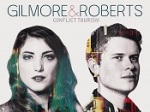 Well, it has to be the oldest building I’ve ever seen a gig in; The Blue Boar in Maldon is about 650 years old and I think The Stones played the opening night. This time it’s folk duo Gilmore and Roberts bringing their blend of fascinating narratives, powerful vocals and constantly changing instrumental arrangements to rural Essex. The Blue Boar gig is the second night of their UK tour in support of the new album “Conflict Tourism”, which was reviewed here a couple of weeks ago, and it’s obvious that after a few weeks in Europe, Katriona Gilmore and Jamie Roberts are up to speed and raring to go.
Well, it has to be the oldest building I’ve ever seen a gig in; The Blue Boar in Maldon is about 650 years old and I think The Stones played the opening night. This time it’s folk duo Gilmore and Roberts bringing their blend of fascinating narratives, powerful vocals and constantly changing instrumental arrangements to rural Essex. The Blue Boar gig is the second night of their UK tour in support of the new album “Conflict Tourism”, which was reviewed here a couple of weeks ago, and it’s obvious that after a few weeks in Europe, Katriona Gilmore and Jamie Roberts are up to speed and raring to go.
I’ve watched a few duos this year and it’s always fascinating to see and hear how two people create diverse and dynamic arrangements for their songs in a live setting. In this case, apart from the obvious blend of two very good voices, you have Katriona’s mandolin and fiddle playing and Jamie’s lap acoustic and standard acoustic playing with a little bit of help from a loop box and a stomp box. Both Katriona and Jamie are warm and engaging between songs, breaking down the barriers between the audience and performers with some gentle self-deprecatory humour, while giving a bit of background with the stories behind the songs.
The first half opened with “Fleetwood Fair”, a song with a traditional lyrical theme featuring Jamie’s lap acoustic guitar with finger percussion, which worked perfectly; superb playing which enhanced the song rather than showing off the technique and the audience were hooked from the start. The two sets were a mix of earlier material (mainly from the 2012 album “The Innocent Left”) and “Conflict Tourism” songs but also a mix of the lively traditional stylings (“Scarecrow” “Peggy Airey”, and “The Stealing Arm”) and the more introspective and sparse singer-songwriter material like “Balance/Imbalance” and “Time Soldiers On”.
The standard was high throughout the set, but there were some breath-taking highlights. During “A Selfish Man” (from “Conflict Tourism”) the audience supplied one part of the vocal counterpoint as the song built to a rousing finish, but Katriona and Jamie had saved the most poignant moment for the encore. There seems to be a bit of a trend towards finishing the night with a completely unplugged song; when it works it creates a sense of intimacy that you don’t often find even in small rooms. This time it was an inspired choice as Katriona and Jamie stepped off the stage to deliver a lovely version of the new album’s closing song, “Ghost of a Ring” to round the night off perfectly.
Gilmore and Roberts have created an intriguing blend of traditional and modern elements in their music, using ancient lyrical themes such as the supernatural (“Jack o Lantern”), potent true stories (“Doctor James” and “Peter Pan”) alongside more modern introspective styles, while adding elements of technology and modern rhythms and techniques (“Cecelia”) to build up the layers of their live sound. It’s an intoxicating brew and you really should make the effort to see them on the remainder of the tour.
 Katriona Gilmore and Jamie Roberts’ fourth album, “Conflict Tourism” is rooted in the conflicts or opposing forces that are in action all around us. The theme is most overt in the album’s central fulcrum, “Balance/Imbalance”, where the first verse (over a minimalist backing) lists a series of familiar dichotomies or polar relationships which suggest balance before tipping over into a second verse suggesting that dark (or is it absence of light) is becoming dominant. It’s one of many fascinating lyrical themes on the album and deliberately positioned at a pivotal point in the centre of the track listing. But let’s just start at the beginning.
Katriona Gilmore and Jamie Roberts’ fourth album, “Conflict Tourism” is rooted in the conflicts or opposing forces that are in action all around us. The theme is most overt in the album’s central fulcrum, “Balance/Imbalance”, where the first verse (over a minimalist backing) lists a series of familiar dichotomies or polar relationships which suggest balance before tipping over into a second verse suggesting that dark (or is it absence of light) is becoming dominant. It’s one of many fascinating lyrical themes on the album and deliberately positioned at a pivotal point in the centre of the track listing. But let’s just start at the beginning.
The opening track “Cecilia” starts with chopped mandolin chords before mutating into industrial folk driven along by Mark Tucker’s panel-beater percussion; the vocal stylings are fairly traditional, but the rhythm patterns are contemporary. Similarly, “Jack O Lantern” takes a mythical lyrical theme and blends it with traditional and contemporary instruments (Phillip Henry’s lap steel and Jamie Roberts’ drum programming) to create a slightly destabilising feel. The lap steel lends a country feel to the beautifully understated “She Doesn’t Like Silence”, which explores the relationship between the public face and the private one, followed by “Selfish Man”, where the conflict is between the two characters’ feelings about motorbike racing (and also the irony of a reason to live becoming a reason for dying).
“Stumble on the Seam” is an interesting combination of folk instruments in the verses (mainly) and rock stylings in the choruses. The narrative is an uplifting tale of a new seam in the Blue John mines in Castleton which was discovered in 2013 after a sixty-eight year search; it’s the classic folk tale of the seemingly impossible quest which is resolved just in time. Following “Balance/Imbalance”, the album moves back towards more traditional folk instrumentation with the uptempo, fiddle-led “Peggy Airey”, the story of a nineteenth Barnsley character, while the slower “Time Soldiers On” has a very simple message; nature moves on and so should we because time only moves in one direction. “Peter Pan” is the story of another Barnsley character, Richard Tolson, this time from the twenty-first century, where the tensions are between an enthusiasm for life and ‘a failing body shutting down before it ought’.
The album’s closing songs continue the personal, modern themes of “Peter Pan”. “Warmonger” is a duet with a melodic upright bass line, which you can read on a personal or political level, while the ethereal “Ghost of a Ring” compares a relationship with a cheap ring which leaves an unsightly verdigris stain which is transient as the memory of the relationship.
While “Conflict Tourism” isn’t quite a concept album, the idea of polarities suffuses the album, which is packed with lyrical and musical invention. Katriona and Jamie take traditional elements like acoustic guitar, mandolin and fiddle, augment them with more modern elements such as programmed beats and industrial percussion to create an ever-changing backdrop for lyrics ranging from simple narrative to evocative poetic imagery. The finished article’s a thought-provoking and satisfying piece of work.
Out on September 18 on GR! Records (GR006).


